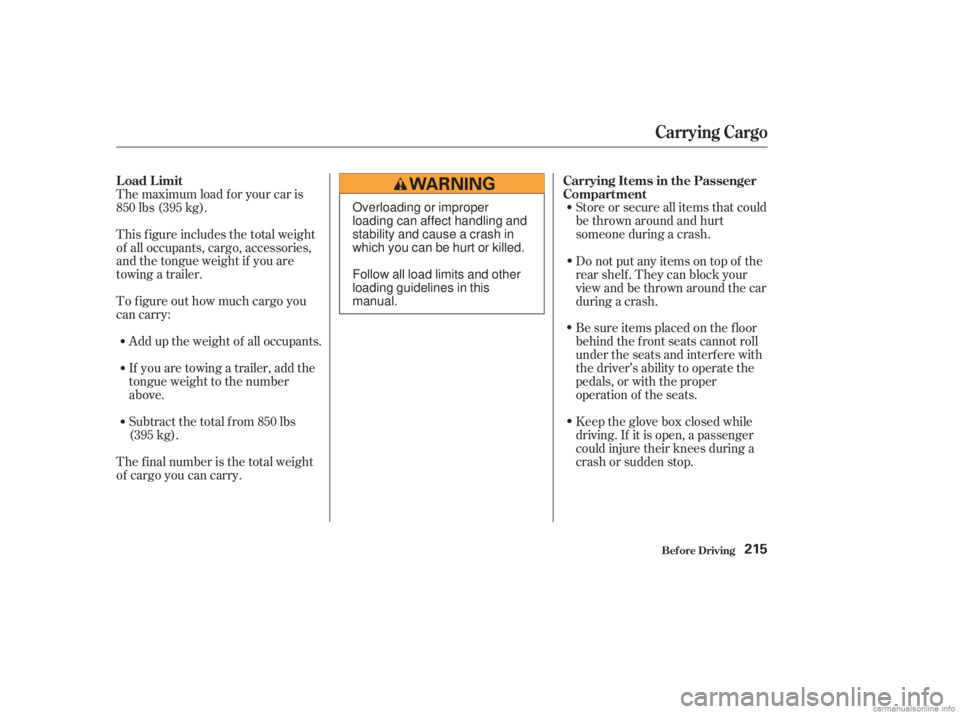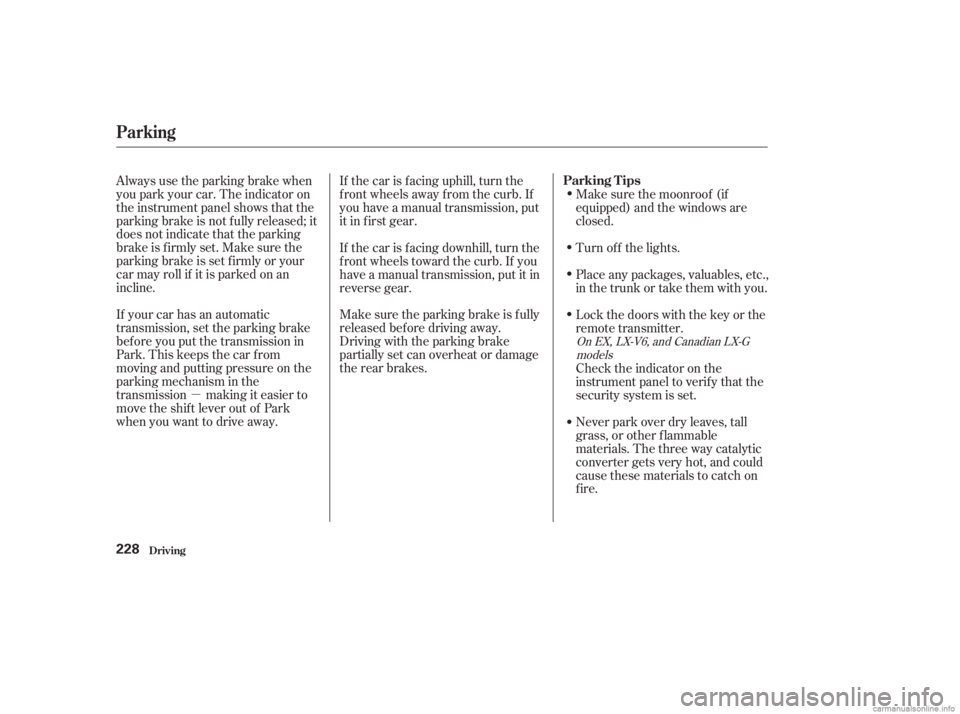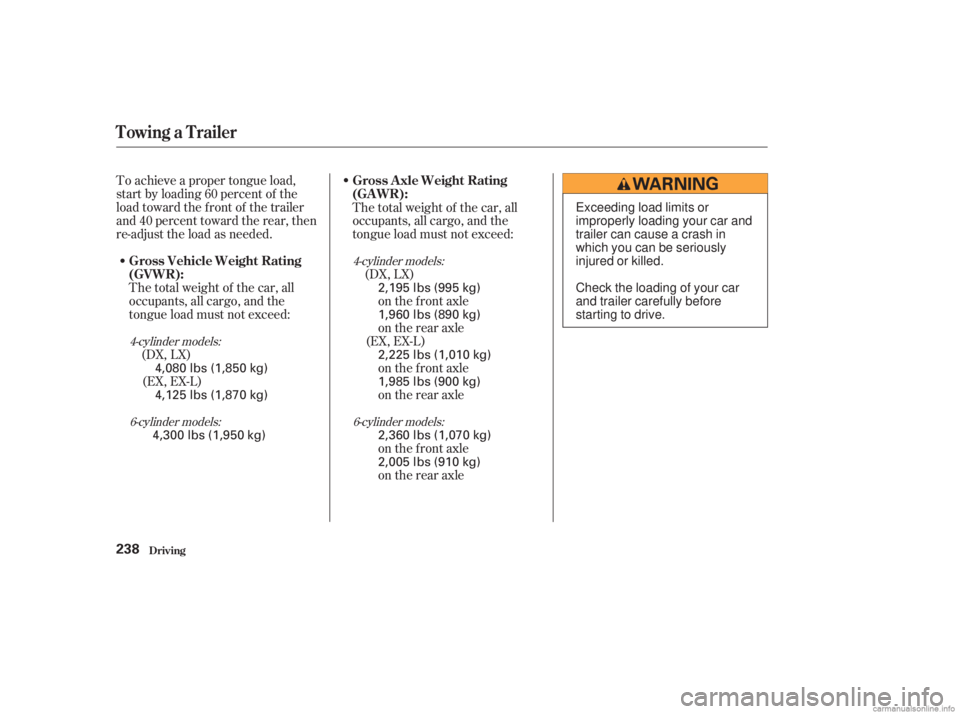Page 211 of 395
Check the engine oil level every time
you f ill the car with f uel. Wait a f ew
minutes af ter turning the engine of f
bef ore you check the oil.Remove the dipstick. Wipe the dipstick with a clean
cloth or paper towel.
1. 2.
Service Station Procedures
Bef ore Driving
Oil Check
208
4-cylinder models
6-cylinder models
DIPSTICK
(Orange Handle)
DIPSTICK
(Orange Loop)
Page 217 of 395
Your car has several convenient
storage areas so you can stow cargo
saf ely.
However, carrying too much cargo,
or improperly storing it, can af f ect
your car’s handling, stability, and
operation, and make it unsaf e.
Bef ore carrying any type of cargo, be
sure to read the f ollowing pages. The glove box, and the pockets in
the doors and seat-backs, are
designed f or small, lightweight items.
The trunk is intended f or larger,
heavier items. In addition, the back
seatcanbefoldeddowntoallowyou
to carry more cargo or longer items.
Carrying Cargo
Bef ore Driving214
CONSOLE COMPARTMENT FRONT DOOR POCKETTRUNK GLOVE BOX
SEAT-BACK POCKET
REAR DOOR POCKET
CENTER POCKET
Page 218 of 395

Store or secure all items that could
be thrown around and hurt
someone during a crash.
Be sure items placed on the f loor
behind the f ront seats cannot roll
under the seats and interf ere with
the driver’s ability to operate the
pedals, or with the proper
operation of the seats.
Keep the glove box closed while
driving. If it is open, a passenger
could injure their knees during a
crash or sudden stop.
This f igure includes the total weight
of all occupants, cargo, accessories,
and the tongue weight if you are
towing a trailer.
The f inal number is the total weight
of cargo you can carry.
If you are towing a trailer, add the
tongue weight to the number
above. Add up the weight of all occupants.
To f igure out how much cargo you
can carry: The maximum load for your car is
850 lbs (395 kg).
Do not put any items on top of the
rear shelf . They can block your
view and be thrown around the car
during a crash.
Subtract the total f rom 850 lbs
(395 kg). Carrying Items in the Passenger
Compartment
Load Limit
Carrying Cargo
Bef ore Driving215
Overloading or improper
loading can affect handling and
stability and cause a crash in
which you can be hurt or killed.
Follow all load limits and other
loading guidelines in this
manual.
Page 220 of 395

This section gives you tips on
starting the engine under various
conditions, and how to operate the
5-speed manual and automatic
transmissions. It also includes
important inf ormation on parking
your car, the braking system, the
Traction Control System, and facts
you need if you are planning to tow a
trailer.........................
Preparing to Drive .218
.......................
Starting the Engine .219
Starting in Cold Weather ....................
at High Altitude .220
....
5-speed Manual Transmission . 221
.....
Recommended Shif t Points . 222
..............
Engine Speed Limiter . 222
..............
Automatic Transmission . 222
.
Shif t Lever Position Indicator . 223
................
Shif t Lever Positions . 223
..............
Engine Speed Limiter . 226
....................
Shif t Lock Release . 226
...........................................
Parking .228
..............................
Parking Tips .228
.....................
The Braking System .229
.............
Brake Wear Indicators . 229
...............
Brake System Design . 230
.......................
Anti-lock Brakes .230
Important Saf ety .........................
Reminders .231
........................
ABS Indicator .231
..............
Traction Control System . 232
...............
TCS ON/OFF Switch . 233
.........
TCSActivationIndicator . 233
...............
Driving in Bad Weather . 235
...........................
Towing a Trailer .237
Driving
Driving217
Page 228 of 395

�µ�µ
�µ To shif t to Second,
pressthereleasebuttonontheside
of the shif t lever. This position locks
thetransmissioninsecondgear.It
does not downshif t to f irst gear
when you come to a stop. Second
gives you more power when climbing,
and increased engine braking when
going down steep hills. Use second
gear when starting out on a slippery
surf ace or in deep snow. It will help
reduce wheelspin. To shif t f rom Second to
First, press the release button on the
side of the shift lever. With the lever
in this position, the transmission
locks in First gear. By upshif ting and
downshif ting through 1, 2, D , and D,
you can operate this transmission
much like a manual transmission
without a clutch pedal.
ForfasteraccelerationwheninD or
D, you can get the transmission to
automatically downshif t by pushing
the accelerator pedal to the floor.
The transmission will shif t down one
or two gears, depending on your
speed. This position is similar
to D, except only the first three
gears are selected instead of all f ive.
Use D when towing a trailer in hilly
terrain, or to provide engine braking
when going down a steep hill. D can
also keep the transmission f rom
cycling between third and f ourth
gears in stop-and-go driving.
3
3
3
3
Second (2) First (1)
Drive (D )
Automatic Transmission
Driving
3
225
Page 231 of 395

�µMake sure the parking brake is f ully
released bef ore driving away.
Driving with the parking brake
partially set can overheat or damage
the rear brakes.
Always use the parking brake when
you park your car. The indicator on
the instrument panel shows that the
parking brake is not f ully released; it
does not indicate that the parking
brakeisfirmlyset.Makesurethe
parking brake is set f irmly or your
car may roll if it is parked on an
incline.
If your car has an automatic
transmission, set the parking brake
bef ore you put the transmission in
Park.Thiskeepsthecarfrom
moving and putting pressure on the
parking mechanism in the
transmission making it easier to
move the shift lever out of Park
when you want to drive away. If the car is f acing uphill, turn the
f ront wheels away f rom the curb. If
you have a manual transmission, put
it in f irst gear.
If the car is f acing downhill, turn the
f ront wheels toward the curb. If you
have a manual transmission, put it in
reverse gear.
Make sure the moonroof (if
equipped) and the windows are
closed.
Lockthedoorswiththekeyorthe
remote transmitter. Place any packages, valuables, etc.,
in the trunk or take them with you. Turn of f the lights.
Never park over dry leaves, tall
grass, or other f lammable
materials. The three way catalytic
converter gets very hot, and could
cause these materials to catch on
fire. Check the indicator on the
instrument panel to verif y that the
security system is set.
On EX, LX-V6, and Canadian LX-G
models
Parking T ips
Driving
Parking
228
Page 240 of 395
Your Honda has been designed
primarily to carry passengers and
their cargo. You can use it to tow a
trailer if you caref ully observe the
load limits, use the proper equipment,
and f ollow the guidelines in this
section.The weight that
the tongue of a f ully-loaded trailer
puts on the hitch should be
approximately 10 percent of the
trailer weight. Too little tongue
load can make the trailer unstable
and cause it to sway. Too much
tongue load reduces f ront-tire
traction and steering control.
The total
weight of the trailer and
everything loaded in it must not
exceed 1,000 lbs (450 kg). Towing
a load that is too heavy can
seriously af f ect your car’s
handling and perf ormance. It can
also damage the engine and
drivetrain.
CONT INUED
Towing a Trailer
Driving
Tongue Load:
Load Limits
T otal T railer Weight:
237
Page 241 of 395

To achieve a proper tongue load,
start by loading 60 percent of the
load toward the front of the trailer
and 40 percent toward the rear, then
re-adjust the load as needed.The total weight of the car, all
occupants, all cargo, and the
tongue load must not exceed: The total weight of the car, all
occupants, all cargo, and the
tongue load must not exceed:
(DX, LX) (EX, EX-L) (DX, LX)
on the f ront axle
on the rear axle
(EX, EX-L)
on the f ront axle
on the rear axle
on the f ront axle
on the rear axle
4-cylinder models:
6-cylinder models: 4-cylinder models:
6-cylinder models:
Towing a Trailer
Driving
Gross Axle Weight Rating
(GA WR):
Gross Vehicle Weight Rating
(GVWR):
238
4,080 lbs (1,850 kg)
4,125 lbs (1,870 kg)
4,300 lbs (1,950 kg) 2,195 lbs (995 kg)
1,960 lbs (890 kg)
2,225 lbs (1,010 kg)
1,985 lbs (900 kg)
2,360 lbs (1,070 kg)
2,005 lbs (910 kg)Exceeding load limits or
improperly loading your car and
trailer can cause a crash in
which you can be seriously
injured or killed.
Check the loading of your car
and trailer carefully before
starting to drive.